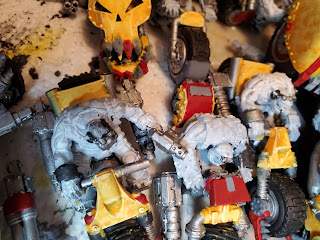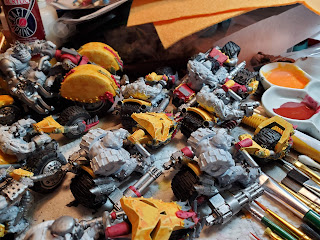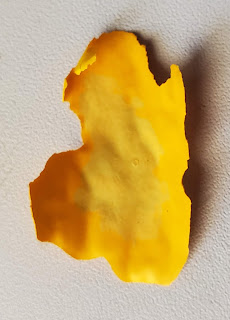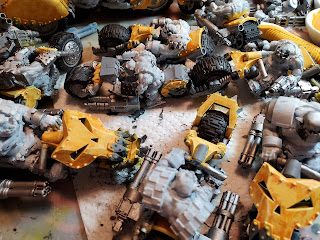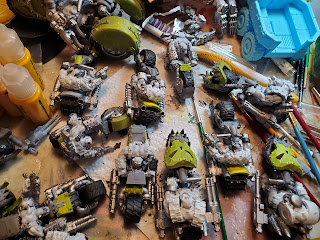This time it's red. Lovely, lovely, pain-in-the-butt red. I won't go into the long winded details of the painting techniques because I did that in Part 4 of this series. You're welcome.
I'm still using craft paints, as the picture below shows. Here's the set of colors this time around.
The specific paints are:- Anita All Purpose Acrylic - 11039 Wine - Pantone 7623
- Anita All Purpose Acrylic - 11003 True Red - Pantone 186
- Anita All Purpose Acrylic - 308062 Light Coral - Pantone 489 (closest, Pantone is darker)
This time there's no white or ivory. Red is one of those annoyingly difficult colors because it's wonderful right up until you get to highlighting. Highlighting means using some other color than red because red plus white equals PINK. While pink is not a terrible color in and of itself it doesn't work well for most things I paint red.
If you look up tutorials you find a lot of different ways to go with red highlights. Because of all the dark yellow on mine I decided to lean into the orange range without actually going orange. I picked that coral color because it's still in the red family while leaning into orange. Coral is one of those colors I dislike for no reason I know. It seems to work for this so now I'm stuck with having coral paint around.
To same some time here's the red and red-coral mixes dried on the parchment paper for your review.
You can see that there's three shades on here. Let me explain them.
Center right - True Red. I like this color. It's a vibrant red with not so great coverage. At least two coats are needed to get this one decent. More on that later.
Lower center - True Red and Coral in about a 3:1 ratio. I'm not exactly sure since I mixed and added until I liked it. This was the color stippled over the base coat.
Upper left - True Red and Coral in about a 4:1 ratio. Again I can't be certain because I mixed on the fly. This one is darker than the first mix because it went on after the glaze.
Not shown - The color from the upper left with more Coral to use as edge highlighting. It was probably about the same as the one in the lower center or slightly lighter.
As you can tell I'm not very concerned about matching these colors again. Orks are wonderful for variation. What I was concerned about was building up a depth of colors.
First up - base coating.
Nothing too fancy here, it's a red base coat. If I were doing fancy painting I would have gone back over all the areas I was going to paint red with white or grey so they were a consistent base. As it is there's black, grey, white, and some yellow under there. There are differences where those change but I didn't think it was important enough to spend the effort.
Base Stipple
As you can see there's a lot of difference between the two colors and it looks pretty harsh. This time I cut down a smaller brush for stippling since I was going to be painting smaller areas. I also did a few lines of the lighter color on the weapons where I wanted a different effect. I'm going to work on that later as I get more into the details.
Glaze
The wine glaze smoothed out those color transitions nicely and added the depth and lining. The red-coral mix is still more visible than the yellow mixes were but that's part of painting red when you're not doing it in lots of layer transitions.
I also moved the glaze around while it was wet so it would have some variation rather than making it smooth. It's kind of subtle but adds to the overall effect.
Second Stipple and Edge Highlights
And the bulk of the red is done. It's still got a kind of pink cast to it in my opinion but not enough to make me want to do anything about it. On the tabletop it isn't all that obvious and with all the other colors that will be involved it won't stand out like it does here.
I'm not going to say the red is done. I know I'll be using red in detailing so there will be more on the models. I don't know what I'm going to do about color, depth, etc. until I get to that point.
One thing that slows down the process now is picking where to paint a color. That happens at the base coat step. Orks are random. Random is more difficult than people think. We like patterns. Trying not to make patterns is frustrating because I keep double checking myself. In this case it's worse because of the prevalence of red in the canon color schemes. I did my best.
Going forward the posts won't be about a single color. I'm past that point in the process. The bulk of the models have been painted and now it's on to the detail work. The technique I use for important colors is well documented (base coat, stipple, glaze, stipple, edge highlight) so I'll do the same as here and just link back to the original post without showing all the stages of the process. Unless I think it looks cool in which case you get to see all the steps.
You will notice I haven't really touched the orks except when I overpainted a color. That's because I consider them a separate object to paint. It would have been very nice if the riders were separate models but they're not so I work with what I have. I did do some black base coats when I was in my black phase and those may or may not stay. It's all about what looks good in the moment really.



